Basic AI Chatbot Pricing: A simple chatbot that can answer questions about a product or service might cost around $10,000 to develop.
Read More

Ever feel like lease management is stuck in the Stone Age, filled with paper trails, endless reminders, and heaps of admin work that could easily be handled by software?
Welcome to the good news: the AI real estate lease management software development revolution is here, and it’s growing at warp speed.
Remember that staggering stat: the global AI in real estate market is projected to skyrocket to a jaw-dropping USD 41.5 billion by 2033 (30.5% CAGR).
That’s not a slow climb; it's a vertical sprint.
So, if you’re thinking “how can real estate companies build lease management software with AI,” you’re not alone, and more importantly, you're on the right track.
From general tools to something purpose-built, the demand for real-time lease tracking, rent collection automation, compliance monitoring, and tenant communication has never been higher.
This blog isn’t just another how-to post. It’s your invitation to get ahead by exploring the development of AI-powered lease tracking software for property managers.
We’ll walk you through everything, from carving out a lean MVP to scaling up into a full-featured lease management powerhouse.
Stick around and by the end, you'll know exactly how to create AI lease management solutions for businesses that drive efficiency, delight tenants, and get the attention of decision-makers ready to partner.
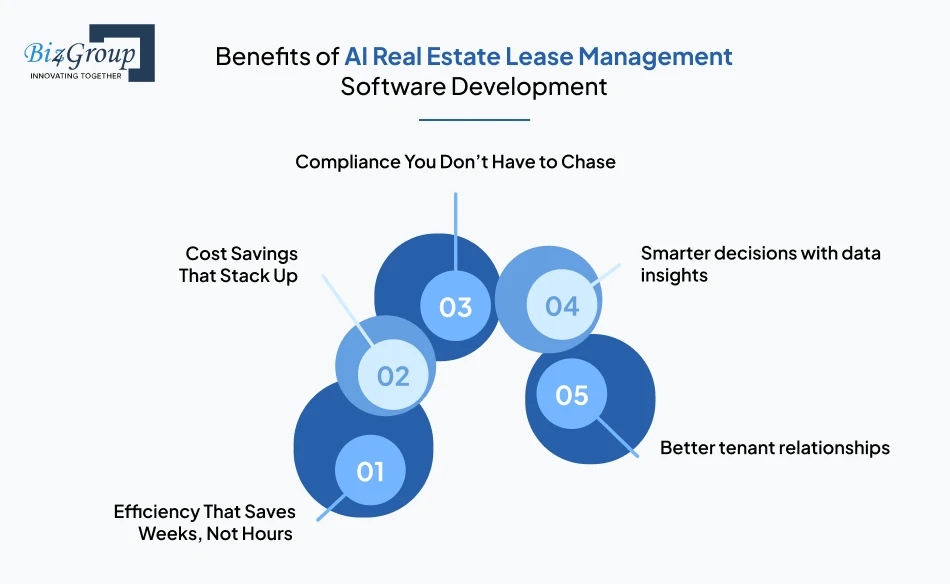
Lease management isn’t just paperwork, it’s the lifeblood of revenue for property managers, real estate firms, and investors.
But the truth is, manual processes are slow, error-prone, and costly. This is why AI real estate lease management software development is no longer a “nice-to-have” but a “must-have.”
Here’s what’s in it for you:
AI lease abstraction tools can extract start dates, termination clauses, and rent details from mountains of documents in minutes.
What used to take paralegals and admins endless hours now happens in a fraction of the time. That’s not just productivity but also peace of mind.
This is the value of expert AI automation services, transforming repetitive tasks into streamlined workflows.
Errors in lease tracking can mean missed escalations, penalties, or overpayments. Automating these processes reduces manual mistakes and trims operational expenses.
Think of it as cutting the fat without losing the muscle.
Real estate regulations are a moving target. AI ensures every critical date, clause, and obligation is tracked so you never miss a compliance deadline.
No more sweating over legal fine print. AI has your back.
Instead of drowning in raw data, property managers get actionable dashboards, vacancy forecasts, rent collection trends, and portfolio health checks.
When the numbers talk, decisions get sharper, a trend already reshaping AI in real estate investment.
Nobody enjoys waiting for an email response about rent dues or renewal terms.
With AI-driven notifications and chatbots, tenants get real-time updates, making their experience smoother and your reputation stronger.
In short, the benefits of AI lease management software aren’t theoretical, they’re measurable, scalable, and transformative.
The payoff? Lower costs, happier tenants, and an operation that actually runs like clockwork.
And speaking of transformation, let’s roll into the next big question: what are the most powerful use cases of AI lease management software development today?
Experience how automation can save time, cut costs, and boost ROI.
Contact Now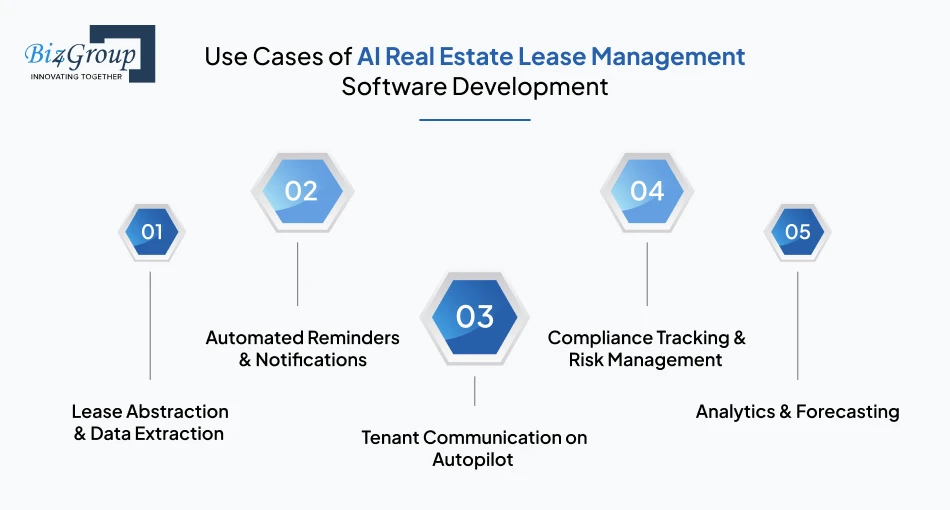
Picture a property manager juggling hundreds of leases, each with different renewal dates, escalation clauses, and compliance requirements. One missed reminder could mean thousands of dollars lost or even a legal dispute.
Now imagine an AI system quietly working in the background, extracting lease data, sending notifications, and surfacing insights before problems ever appear.
That’s the magic of AI real estate lease management software development.
Let’s look at where it makes the biggest impact:
No more late nights with coffee and highlighters. AI scans:
You get instant clarity without the paper chase.
AI doesn’t forget. Whether it’s a rent escalation, lease expiry, or compliance deadline, automated alerts keep property managers and tenants on schedule.
Missed opportunities? Not anymore.
Tenants want answers now, not after a week of email back-and-forth. This is why developing AI chatbot is essential.
AI chatbots handle routine questions and reminders 24/7, making your business look sharp while freeing up your team.
Real estate laws aren’t exactly light reading.
You stay compliant without becoming a legal scholar.
This is where AI earns its keep. Portfolio-wide dashboards:
Decisions shift from guesswork to data-backed strategy.
These use cases aren’t just fancy features, they’re battle-tested ways to save time, cut costs, and impress clients.
For a broader perspective, see how to use AI for real estate in 2025.
Now that we’ve seen how real estate companies can build lease management software with AI for real-world results, let’s move on to the must-have features every MVP should include.
If your lease management software doesn’t go beyond a glorified spreadsheet, then it’s not really helping.
The whole point of AI real estate lease management software development is to simplify the complex, automate the repetitive, and make property managers look like superheroes without the cape.
That starts with the right features baked into your MVP.
Here’s what should absolutely make the cut:
| Feature | What It Does | Business Value |
|---|---|---|
|
AI Lease Abstraction |
Scans and extracts key data points (dates, clauses, rent terms) from leases |
Saves weeks of manual work and reduces errors |
|
Centralized Document Repository |
Stores all lease documents in one secure, searchable hub |
Easy access, no more lost files, streamlined audits |
|
Automated Notifications & Reminders |
Sends alerts for renewals, escalations, payments, and compliance deadlines |
Prevents costly oversights and ensures timely actions |
|
Integrated Rent Collection |
Connects with payment gateways for auto rent collection and receipts |
Improves cash flow and reduces manual accounting |
|
Compliance Tracking |
Monitors obligations, deadlines, and regional regulations |
Minimizes risk of fines and keeps you audit-ready |
|
Analytics Dashboard |
Provides real-time visibility into lease performance and portfolio health |
Data-driven decisions instead of guesswork |
|
Tenant Communication Tools |
AI chatbots or integrated messaging for tenant queries |
Enhances tenant satisfaction and reduces support burden |
These must-have features form the backbone of a strong MVP. They’re practical, impactful, and give your team the breathing room to focus on growth rather than paperwork.
But once the basics are covered, the fun really starts with advanced features that take things from efficient to extraordinary.
Let’s see what those look like.
Discover the must-have tools that make your lease management smarter.
Build with UsOnce the essentials are in place, it’s time to add some muscle.
The core features keep you afloat, but the advanced ones? They turn your software into the kind of tool real estate pros brag about at industry meetups.
That’s the real edge of AI real estate lease management software development.
Here’s what takes your solution from “useful” to “game-changing”:
These features are the difference between keeping up with the competition and leaving them behind.
Now that we’ve got the wishlist of capabilities, let’s map out the step-by-step process to develop AI real estate lease management software that delivers them.

Developing software isn’t just about coding, it’s about crafting a solution that genuinely solves problems. AI real estate lease management software development is no exception.
The process has to balance technical rigor with business sense, and creativity with compliance.
Skip the sequence, and you risk building a shiny tool that no one actually uses.
Follow it, and you get a product that evolves from MVP to a market-ready powerhouse.
Here’s the roadmap to make it happen:
Every winning product starts with listening, not coding.
This is your compass. Get discovery right, and the rest of the journey stays on course.
Think of this stage as packing for a trip. You can’t take everything at once.
The beauty of an MVP is that it’s designed to evolve. You don’t need to serve the entire buffet, just the dishes people are most hungry for.
Also read: Top 12+ MVP Development Companies in USA
No one sticks with clunky software, no matter how smart the AI is. Partnering with a UI/UX design company can help you:
A sleek, intuitive interface makes adoption frictionless.
Because in the end, if people don’t enjoy using the product, they simply won’t.
Also read: Top 15 UI/UX Design Companies in USA
This is where the software gets its “smarts.”
AI isn’t magic, it’s math powered by data. The stronger your training dataset, the more reliable your lease management AI will be.
The best software doesn’t live in isolation. It plugs into your ecosystem.
Professional AI integration services can transform your product from “another tool” to “the hub” of real estate operations.
Launching without testing is like renting a property without inspecting the roof.
Testing isn’t a checkbox, it’s a rehearsal for real-world adoption.
Nail this, and scaling becomes less of a gamble.
This is where theory meets reality.
Scaling is not a sprint, it’s an iterative climb.
Each layer of features makes your software stronger, smarter, and more market-ready.
Because even “finished” software is never truly finished.
This step ensures your software doesn’t just launch but also lasts.
When you zoom out, this process isn’t just about development, it’s about building trust with users and creating long-term value. The path from MVP to a full-fledged lease management platform isn’t linear, but with the right process, it’s always forward-moving.
Also read: How to Build Real Estate AI Software?
Now that we know how to develop AI real estate lease management software step by step, let’s look under the hood at the tech stack that makes it all possible.
We make the process simple, seamless, and scalable for your business.
Schedule a Free CallA lease management MVP may look simple on the outside, but under the hood, it’s powered by a sophisticated blend of frameworks, libraries, and cloud services.
Choosing the right tech stack is like choosing the right construction materials for a skyscraper. It determines stability, speed, and long-term scalability.
Here’s how the stack breaks down:
The frontend is the first handshake with your users. If it feels clunky, you lose them.
| Technology | Purpose | Why It Matters |
|---|---|---|
|
Builds interactive web interfaces |
Fast, scalable, widely supported |
|
|
Angular |
Alternative frontend framework |
Great for enterprise-grade apps |
|
Flutter |
Cross-platform mobile app development |
A smooth UI makes or breaks adoption because no one wants to manage leases on something that looks like it was built in 2005.
This is where all the business logic and integrations live. It has to be strong, secure, and flexible.
| Technology | Purpose | Why It Matters |
|---|---|---|
|
Event-driven server-side framework |
Handles multiple requests efficiently |
|
|
Python (Django/Flask) |
Backend + AI-friendly |
Great for data-heavy and AI apps |
|
Java Spring Boot |
Enterprise backend framework |
Reliable, scalable, robust |
The backend ensures your lease management system is more than a pretty face. It’s the reliable engine under the hood.
This is what makes your software “AI-powered” rather than just automated.
| Technology | Purpose | Why It Matters |
|---|---|---|
|
TensorFlow |
Deep learning framework |
Robust for training custom AI models |
|
PyTorch |
Alternative ML framework |
Flexible, developer-friendly |
|
spaCy |
Natural Language Processing |
Perfect for extracting meaning from contracts |
Without AI/NLP, you’re just digitizing leases. With it, you’re transforming them into living, searchable, actionable data.
Leases still arrive as PDFs, scans, or even faxes (yes, those still exist). OCR is what makes them machine-readable.
| Technology | Purpose | Why It Matters |
|---|---|---|
|
Tesseract OCR |
Open-source OCR engine |
Cost-effective and flexible |
|
AWS Textract |
Cloud OCR by Amazon |
High accuracy, integrates with AWS stack |
|
Google Vision AI |
OCR + image recognition |
Strong multilingual and handwriting support |
OCR is the unsung hero. Without it, AI has nothing useful to analyze.
If data is the new oil, databases are your pipelines.
| Technology | Purpose | Why It Matters |
|---|---|---|
|
PostgreSQL |
Relational database |
Great for structured lease data |
|
MongoDB |
NoSQL database |
Handles unstructured or semi-structured data |
|
Elasticsearch |
Search and indexing engine |
Blazing-fast search for contracts and clauses |
Think of databases as your digital filing cabinets, only faster, smarter, and incapable of losing a file.
Cloud platforms ensure scalability, security, and global reach.
| Technology | Purpose | Why It Matters |
|---|---|---|
|
AWS |
Cloud computing services |
Flexible, wide AI/ML support |
|
Microsoft Azure |
Cloud + enterprise integrations |
Great for large real estate firms |
|
Google Cloud Platform |
AI-first cloud platform |
Excellent NLP and OCR APIs |
The cloud is the backbone. It scales as you grow and keeps your data secure while ensuring 24/7 availability.
Lease management software never works in isolation. Integrations make it valuable.
| Integration | Purpose | Why It Matters |
|---|---|---|
|
QuickBooks/Xero |
Accounting software |
Automates rent collection and reconciliation |
|
Salesforce/HubSpot |
CRM |
Connects tenant communications with leasing workflows |
|
Yardi/MRI |
Property management software |
Extends capabilities into asset/portfolio management |
Integrations turn your lease management software into the central command center instead of “just another tool.”
The right stack is a mix of proven frameworks, cutting-edge AI tools, and scalable cloud infrastructure.
But remember, tech alone doesn’t guarantee success. Security and compliance are just as important.
Which brings us to the next crucial chapter: how to keep your AI lease management system safe, secure, and regulation-proof.
When millions of dollars in lease agreements sit in your database, you can bet hackers, regulators, and auditors are paying attention.
Cutting-edge features mean nothing if your system isn’t airtight. That’s why security and compliance in the development of AI lease management systems for real estate investors isn’t an afterthought, it’s the foundation.
Lease agreements contain sensitive financial and personal details. Losing that data is not an option.
In short, privacy is what keeps clients confident that their information is safe.
Not everyone should have the same level of access to lease data.
Think of it as handing out spare keys. You don’t give one to just anyone.
Real estate regulations are evolving, and AI is under growing scrutiny.
Regulation may sound like red tape, but it’s also your safety net against lawsuits and penalties.
A well-secured system isn’t just secure but also certified to show it.
Because in enterprise real estate, logos of certification badges speak louder than promises.
AI is powerful, but it can also inherit flaws from training data.
This ensures AI is an assistant, not an unchecked decision-maker.
Security and compliance are about earning trust. And trust is exactly what convinces investors, owners, and managers to adopt your product.
Now that we’ve locked down safety, let’s talk about the next thing everyone asks first: how much does it actually cost to make AI real estate lease management software for your business?
Sticker shock first, clarity right after.
A realistic budget to make a solid MVP lands around $40,000 to $120,000+, while scaling into a full production platform ranges from $180,000 to $600,000+ depending on scope, AI depth, and integrations.
That is the short answer.
The longer answer explains where each dollar works for you in AI real estate lease management software development.
Getting the estimate right starts with the levers you can actually control.
Tune these, and your budget behaves.
More modules equals more engineering.
Estimate: adding or removing features can swing budgets by $10,000 to $60,000.
Result: keep MVP tight to prove value fast.
Basic OCR and rules are cheaper than custom NLP and retraining pipelines.
Estimate: $8,000 to $50,000 uplift based on custom models, datasets, and evaluation.
Result: start simple, upgrade once you see ROI.
Each connection to ERP, CRM, accounting, or PMS adds moving parts.
Estimate: $5,000 to $40,000 per integration depending on auth, data mapping, and testing.
Result: prioritize the two that unlock the most value.
Web only is lean. Web plus iOS plus Android adds parallel tracks.
Estimate: $5,000 to $25,000 for UX depth and $10,000 to $35,000 per additional platform.
Result: start web first, expand when adoption justifies it.
Role based access, encryption, audits, and policy work are non-negotiable for investors and enterprises.
Estimate: $5,000 to $30,000 initial hardening and audit prep.
Result: spend here to win trust and shorten sales cycles.
Multi property portfolios need stable speed under load.
Estimate: $5,000 to $20,000 for caching, queues, and load tests.
Result: smooth performance keeps support costs down.
Senior architects and data scientists cost more but de risk delivery.
Estimate: the same scope may vary by $15,000 to $80,000 across regions and seniority.
Result: blend senior oversight with efficient execution.
Strong PM and QA save rework later.
Estimate: $8,000 to $25,000 for structured sprints, test automation, and UAT.
Result: fewer surprises at launch.
A smart MVP trims these levers with purpose.
That way you develop AI real estate lease management software on budget and on target.
This is the journey from first whiteboard to a full platform.
Short intros, clear outputs, honest timelines.
| Phase | Scope Highlights | Timeline | Estimated Cost |
|---|---|---|---|
|
Discovery and UX blueprint |
Workshops, requirements, user flows, wireframes |
2 to 3 weeks |
$6,000 to $20,000 |
|
MVP build |
Lease abstraction, document hub, alerts, basic dashboards, core roles |
6 to 10 weeks |
$40,000 to $120,000 |
|
Pilot and UAT |
Limited tenant roll out, real lease datasets, bug fixes, polish |
2 to 4 weeks |
$8,000 to $25,000 |
|
Scale up to full product |
Predictive analytics, contract drafting, portfolio tools, extra integrations |
8 to 16 weeks |
$80,000 to $300,000 |
|
Enterprise hardening |
SSO, advanced RBAC, audit logs, performance tuning |
3 to 6 weeks |
$25,000 to $80,000 |
|
Care and feeding |
Support, SLAs, monitoring, minor features, AI model refresh |
Ongoing monthly |
$3,000 to $15,000 per month |
Each phase builds momentum.
You create AI lease management solutions for businesses that earn trust early, then scale with confidence.
They are not glamorous, but they keep your product reliable in the real world.
Short paragraphs, real numbers, fewer surprises.
Data Preparation and Labeling
Cleaning leases, redacting PII, and tagging clauses is the difference between average accuracy and production grade performance.
Expect $3,000 to $30,000 based on volume and languages.
Plan it early so your models start learning from day one.
OCR, embeddings, and storage add up as your portfolio grows.
Budget $500 to $5,000 per month at MVP scale and $2,000 to $15,000 per month at full scale.
Right sizing instances and batching jobs keeps this bill friendly.
Privacy policies, tenant notice templates, and regional compliance checks need expert eyes.
Set aside $4,000 to $20,000 during MVP to avoid costly rewrites later.
The payoff is faster enterprise approvals.
Teams need onboarding on new workflows and dashboards.
Allocate $2,000 to $15,000 for live sessions, guides, and micro videos.
Adoption rises when training feels practical, not theoretical.
Independent validation matters to asset managers and investors.
Plan $5,000 to $25,000 annually.
These reports close deals and reduce risk in one move.
Models drift as leases and regulations evolve.
Reserve $1,500 to $10,000 per quarter for evaluation, re training, and dataset refresh.
Consistent accuracy keeps your analytics trustworthy.
Unexpected mapping, legacy systems, or rate limits can require extra engineering.
Keep a $2,000 to $10,000 contingency per new connector.
This cushion turns surprises into solved problems.
Hidden costs are not really hidden once you expect them. When you build AI real estate lease management software with these in mind, budgets stay calm and roadmaps stay believable.
Get a tailored estimate that fits your budget and business goals.
Get a Custom QuoteBuilding software is an investment, but the smartest companies know how to stretch every dollar while turning the platform into a revenue engine.
When you create AI lease management solutions for businesses, you’re not just shaving costs, you’re also building a product that can pay for itself (and then some).
Here’s how to keep your budget lean without cutting corners.
| Tactic | Explanation | Cost Impact |
|---|---|---|
|
Start with a focused MVP |
Launch with core features (abstraction, alerts, dashboards) before adding advanced AI |
Saves 20–40% upfront development costs |
|
Leverage cloud-native services |
Use managed OCR, AI, and hosting services (AWS, GCP, Azure) instead of building from scratch |
Reduces infra costs by 15–30% |
|
Adopt modular architecture |
Build software in reusable components, so adding features later doesn’t require rework |
Cuts scaling costs by 25%+ |
|
Use open-source frameworks |
Rely on React, Django, Tesseract OCR, etc., where feasible |
Eliminates $10,000–$50,000 in licensing |
|
Outsource non-core tasks |
Offshore or hybrid teams for QA, support, or data labeling |
Lowers team costs by 20–50% |
|
Automate testing early |
Continuous integration and test automation reduces long-term QA expenses |
Saves 10–15% in ongoing dev |
Small tweaks add up fast.
What looks like minor savings per phase can stack into six figures over the lifecycle.
Once your costs are under control, it’s time to make the software earn its keep.
When you make AI real estate lease management software for your business, the real payoff is turning it into both a cost-saver and a profit center.
Optimizing costs keeps your roadmap sustainable. And monetization strategies turn your product into an asset that generates revenue while solving client problems.
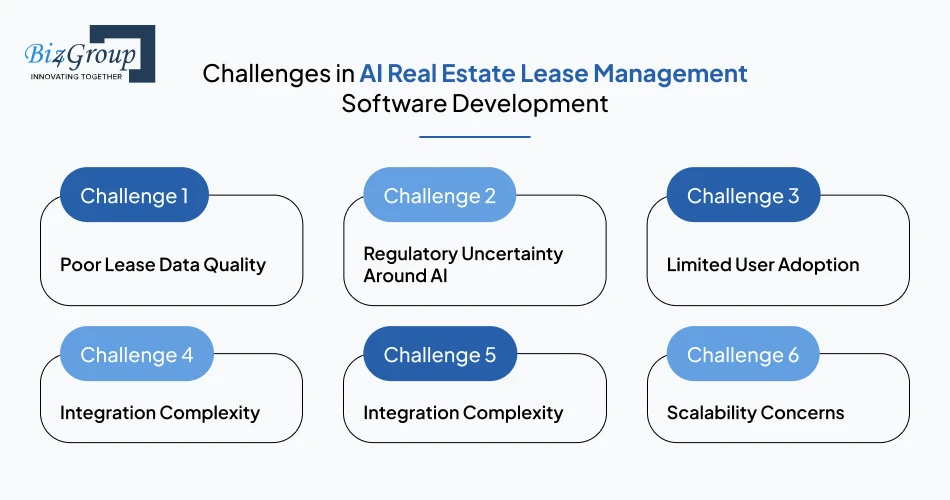
Every groundbreaking product has its bumps in the road. AI real estate lease management software development is no exception.
Between data hurdles, user adoption, and evolving regulations, challenges show up fast.
The good news? Each one comes with a solution, if you know where to look.
Most leases aren’t uniform, they come in PDFs, scans, handwritten notes, or even photos. Training AI on messy inputs leads to errors.
Solution:
High-quality data in means reliable insights out.
AI in real estate is under the microscope. Some regions are even banning rent-setting algorithms.
Ignoring this could backfire.
Solution:
Compliance isn’t a hurdle. It’s a moat that protects your software from being obsolete.
Even the smartest software fails if property managers stick to spreadsheets.
Solution:
A product only wins if people actually want to use it.
Real estate tech stacks already include CRMs, accounting tools, and property management systems.
Poor integrations frustrate users.
Solution:
Smooth integrations turn your software into the centerpiece of operations.
Lease formats, laws, and language evolve. AI trained today may miss the mark tomorrow.
Solution:
Continuous learning ensures your software stays sharp year after year.
What works for 50 leases may crumble with 5,000 if scalability isn’t planned.
Solution:
Scalability is the difference between a niche tool and a market-ready platform.
Mistakes sneak in when teams try to sprint without a roadmap.
Avoid these, and you’ll save both money and credibility:
Challenges test your resilience, but mistakes test your discipline.
Solve the first, avoid the second, and you’ll be ahead of 90% of the competition.
Now, let’s flip the lens forward and explore the future trends in AI real estate lease management software development that are shaping the industry.
Turn your challenges into opportunities with AI-powered solutions.
Talk to Our Experts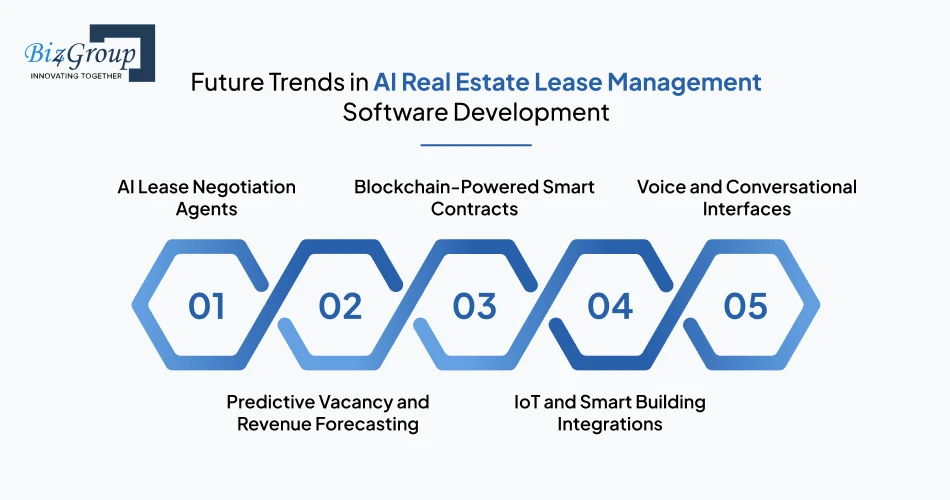
Imagine that it’s 2030, and a property manager doesn’t just track leases, they also predict market shifts, negotiate contracts with AI co-pilots, and manage portfolios through voice commands.
That’s not sci-fi, it’s the trajectory of AI real estate lease management software development. The pace of innovation is fast, and those who prepare now will be tomorrow’s industry leaders.
Here are the trends shaping the road ahead:
Imagine AI tools suggesting fair rent escalations, highlighting risky clauses, and even drafting negotiation-ready addendums.
These negotiation assistants won’t replace lawyers but will dramatically cut the prep time for deal-making, and working with an AI agent development company is key to unlocking these negotiation-ready tools.
Impact: Faster, more accurate lease negotiations, with cost savings of up to 30% in legal review hours.
Today’s dashboards report the past, tomorrow’s dashboards will forecast the future.
By combining market data, tenant behavior, and historical trends, AI will predict vacancies before they happen and project revenue streams months ahead.
Impact: Proactive planning for asset managers and reduced surprises in portfolio performance.
Smart contracts, often explored in AI real estate marketplace development, will enable fully automated lease execution.
Payment triggers, compliance checks, and renewals can be written into blockchain-based agreements, minimizing disputes and ensuring transparency.
Impact: Greater trust, faster execution, and fewer costly legal disputes.
IoT devices, like sensors for occupancy, energy usage, or maintenance triggers, will connect directly with lease management software.
This data will feed AI models that align lease terms with real-world property usage.
Impact: Smarter facilities management and leases that adapt to actual usage, not just static terms.
Forget dashboards, managers will simply ask, “Which leases are expiring in Q3?” and get an instant answer.
Voice-enabled AI and conversational interfaces will make lease management hands-free and faster than ever.
Impact: Greater accessibility, quicker decisions, and reduced training curves for new users.
Also read: The Role of AI for Real Estate Agents in 2025
The future of AI lease management is about efficiency, intelligence, automation, and user experience converging into one seamless system.
Now, the big question: when businesses need to build AI real estate lease management software that actually delivers on this future, who should they trust to lead the way?
Here’s who...
The real estate industry is changing at lightning speed.
From AI-driven lease management to automated contract handling and tenant engagement, businesses are now leaning on intelligent software to do what traditional systems never could.
But guess what? Building AI-powered real estate solutions requires more than coding. It demands a team that understands both real estate complexities and AI innovation.
That’s exactly where Biz4Group comes in.
We are a trusted real estate AI software development company, your trusted advisors who have guided startups, enterprises, and industry leaders through their digital transformation journeys.
With years of experience in AI, IoT, cloud, and custom product development, we’ve successfully delivered solutions that are shaping the future of real estate.
Our clients don’t just rely on us for technology; they rely on us for strategy, execution, and results that outlast trends.
Here’s why companies choose Biz4Group:
Our portfolio reflects our ability to solve real-world real estate challenges. From managing complex property listings to streamlining lease agreements, as a real estate website development company, we’ve built platforms that simplify processes, boost user engagement, and increase ROI.
We’re with you at every stage, from brainstorming your product idea to building, deploying, and scaling it. That means you get more than AI developers; you get a team that ensures every detail is carefully designed, tested, and optimized for long-term growth.
Off-the-shelf solutions don’t work in real estate. Every business has unique workflows, regulations, and customer experiences. That’s why we design AI features like predictive analytics, OCR-based document parsing, and chatbots that are trained for your business needs.
We work with the latest technologies to keep your platform future-proof. From advanced AI/NLP integrations and secure cloud hosting to interactive dashboards and payment gateways, our solutions are designed to scale effortlessly as your business grows.
For us, success isn’t just about delivering software; it’s about building relationships. We’ve earned long-standing partnerships because we commit ourselves to our clients’ success and stand by them as technology partners in every phase of their growth.
Need proof? Check out our work in the real estate industry.
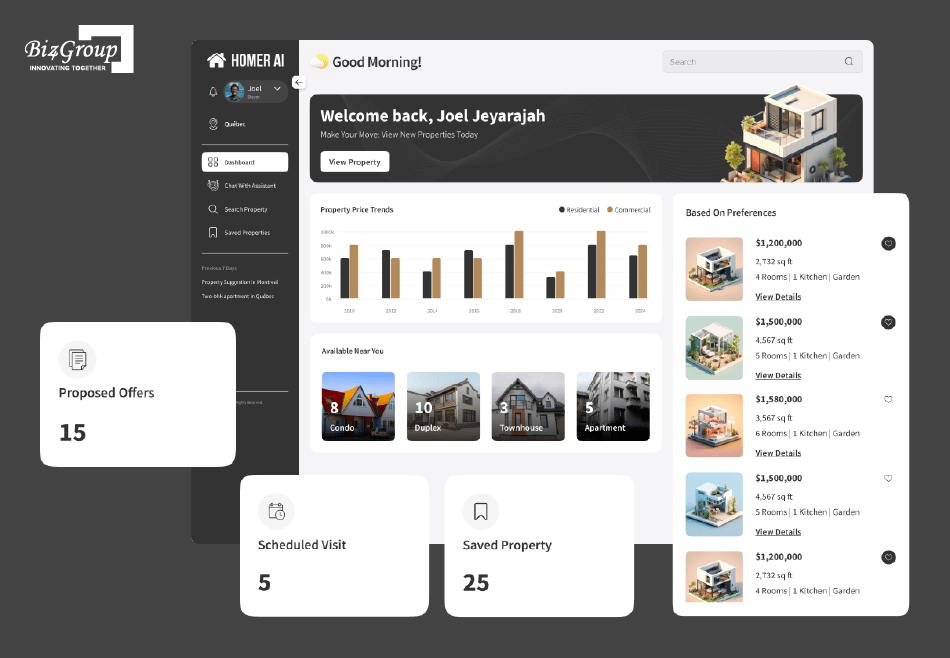
A modern AI-driven property management application built to bring buyers and sellers together. From conversational chatbots that recommend properties to advanced 3D views, scheduling visits, and personalized dashboards, we engineered Homer AI to give users a seamless property search and listing experience.
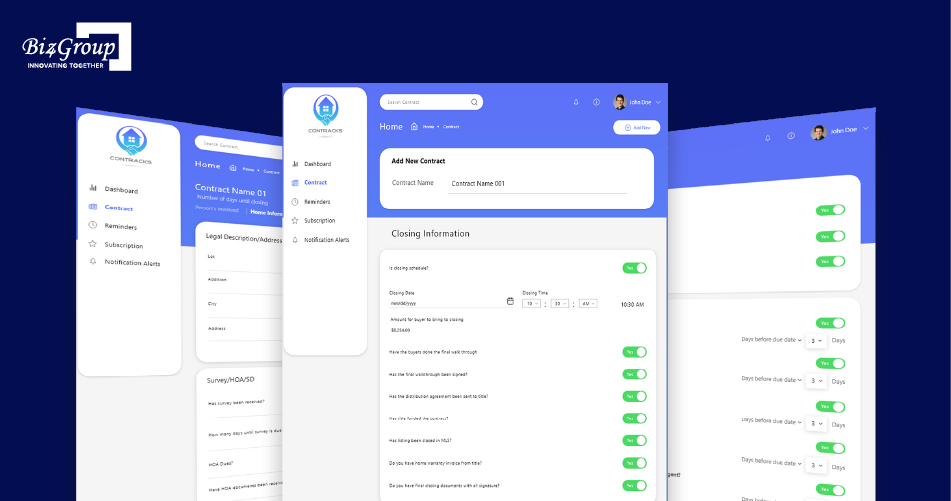
A next-generation contract management platform designed for real estate professionals. We developed Contracks with features like AI-powered contract summarization, milestone reminders, financial mapping, multi-party contract handling, and secure digital payments, helping agents and brokers cut through the noise of paperwork.
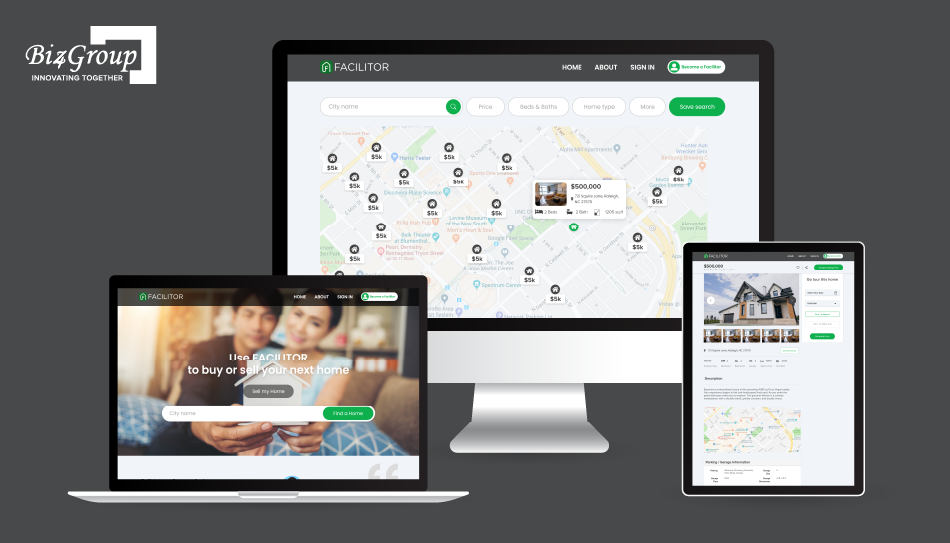
A property buying and selling platform that redefines safe and smart transactions. We built Facilitor with AI-driven property recommendations, video-based virtual tours, realtor-assisted visits, and financial verifications, bridging the communication gap between buyers and sellers.
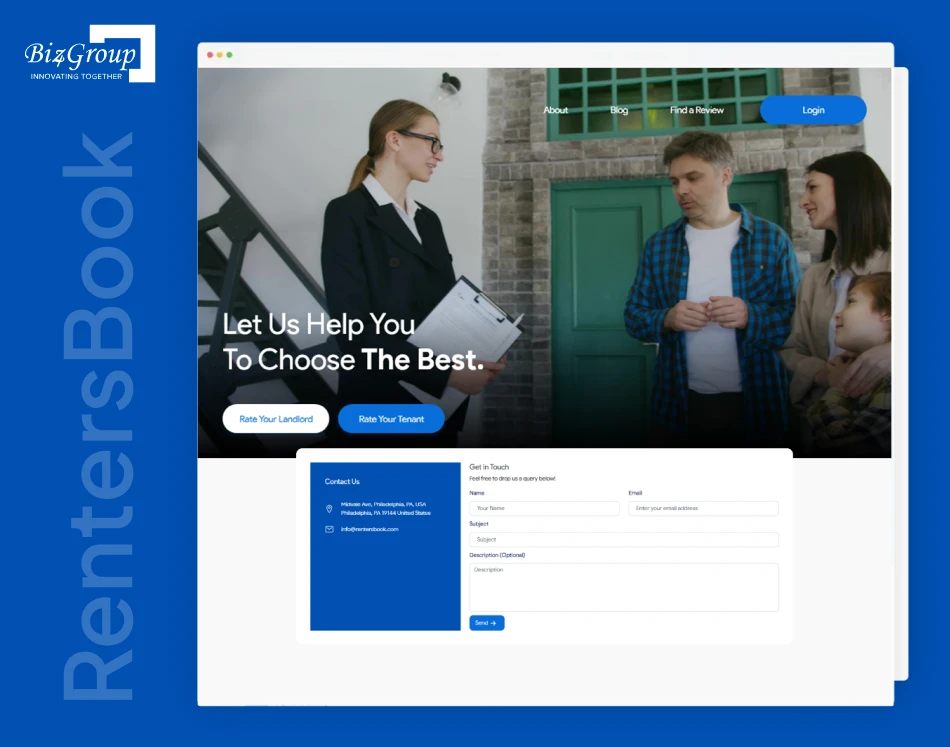
A transparent review and rating ecosystem for tenants and landlords. With verified feedback, smart search capabilities, and robust data protection, we designed Renters Book to create trust in rental and lease agreements, empowering users to make better decisions.
Partnering with Biz4Group means putting your project in the hands of experts who understand both the business side of real estate and the technical side of AI development.
We bring together a unique mix of creativity, innovation, and technical expertise to deliver products that don’t just solve today’s challenges but also prepare you for tomorrow’s opportunities.
We’ve done it before, and we’ll do it again, for you.
Whether you’re looking to build a property management tool, an AI-powered lease automation system, or a full-scale tenant engagement platform, our team has the skills and experience to bring your vision to life.
So why settle for ordinary when you can build extraordinary with us?
Let’s connect and start building your next big AI real estate solution today.
The future of real estate lies in automation, intelligence, and customer-centric digital platforms.
From AI-powered lease management systems to secure contract handling and tenant engagement tools, technology is not just transforming workflows but redefining how the industry operates. Companies that adopt these solutions now will gain a strong competitive edge in an increasingly digital-first market.
However, success in this space requires more than just technology. It demands vision, execution, and a partner who understands both real estate and innovation.
This is where Biz4Group makes the difference.
As a top software development company in USA and with a proven track record in building cutting-edge real estate platforms like Homer AI, Contracks, Facilitor, and Renters Book, Biz4Group has helped businesses embrace digital transformation with confidence.
If you are ready to explore the potential of AI in lease management or want to build a real estate solution that stands out in the market, Biz4Group is the partner you can trust.
Let’s shape the future of real estate together.
Security is critical when handling financial data, tenant records, and contracts. A reliable lease management platform should offer multi-factor authentication, role-based access, data encryption (both in transit and at rest), regular security audits, and GDPR/CCPA compliance to keep sensitive information safe.
Yes. Most modern platforms are built with API capabilities that allow seamless integration with popular accounting tools. This ensures that rent collection, expense tracking, and financial reporting are automatically synced without manual data entry.
AI enhances lease management by automating data extraction from documents, predicting late payments, providing smart reminders, and offering insights on tenant behavior. It reduces human error, accelerates decision-making, and ensures contracts are managed efficiently.
Cloud-based systems are generally preferred because they offer remote access, real-time updates, scalability, and lower upfront costs. On-premise solutions may still work for organizations with strict data residency requirements, but they often demand higher maintenance and IT involvement.
Scalability depends on the platform’s architecture. A good system should allow you to easily add new properties, tenants, and users without performance issues. Many enterprise-grade AI solutions are designed to support growth from a handful of leases to thousands.
Yes. Advanced solutions come with built-in compliance tools that track critical deadlines, alert managers of upcoming renewals or inspections, and store audit-ready documentation. This reduces the risk of penalties and ensures regulatory adherence.
with Biz4Group today!
Our website require some cookies to function properly. Read our privacy policy to know more.